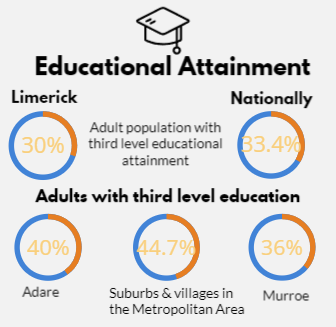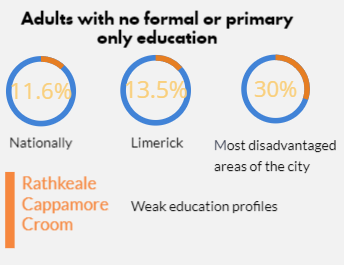2.3 Educational Attainment
A trend reflected across the state generally is the increase in the level of educational attainment in the adult population.
Higher levels of educational qualification in Limerick
In 2016, 30% of the population aged 15 years and over in Limerick City and County had third level educational qualifications. This was lower than the national average of 33.4%. The distribution of persons with higher levels of educational qualifications varies across sub-areas of Limerick. In the inner and outer suburbs and villages in the Metropolitan Area, large percentages of adults have third level education. For instance, 44.7% of the adult population in the suburbs and outer Metropolitan Area have third level qualifications compared with 25% in the former Limerick City Council area.

Educational attainment levels are generally higher in rural Limerick (the former County compared with the former City Council area). In rural Limerick, the settlements with the best education profile are Murroe and Adare, having the highest percentage of adults with third level education (40% in Adare and 36% in Murroe) and the lowest percentages of adults with Primary Only or No Formal Education and Lower Secondary at most.
Bruff and Newcastle West present a balanced picture. Both have a relatively high percentage with third level education and low percentage with low education compared with other settlements.
Some towns have a high proportion of adults with vocational qualifications – Newcastle West and Killmallock – which traditionally have been locations of manufacturing employment – and Cappamore and Bruff.
Lower level educational qualification Limerick
In Limerick City and County, 13.5% have at most Primary Education or No Formal Education. The actual number of adults in this category is 16,938 – 6, 250 adults in the former city and 10,688 in the former county. The rate with lowest education in Limerick is higher than the national average (11.6%). Low education is a significant issue in the city. There are nine Electoral Divisions across the city and county where 30% of the adult population state “No formal or primary education only” as their highest level of qualification. Eight of these Electoral Divisions are in the city (and one in Rathkeale). Low levels of educational attainment is a characteristic of Limerick’s most deprived urban areas. Across all of the regeneration areas of the city, 60% or more of the adult population have lower secondary education or below as the highest level of qualification.
 Of the county towns, Rathkeale has the weakest education profile. It has, by far, the highest percentage of adults with Primary / No Formal Education – which reflects large concentrations of Traveller families in the town – and the second lowest percentage with third level education.
Of the county towns, Rathkeale has the weakest education profile. It has, by far, the highest percentage of adults with Primary / No Formal Education – which reflects large concentrations of Traveller families in the town – and the second lowest percentage with third level education.
Cappamore and Croom also have a relatively weak education profile (high percentage with low education and small percentage with third level education). Cappamore has the lowest percentage of adults with third level education. This is associated with the older age structure of residents of the town.
Generally, low education is difficult to capture in rural Limerick as persons with lowest education can be widely dispersed. Adults with low education may be unemployed, in work, retired or economically inactive. Delivery of learning opportunities to dispersed rural population present challenges in terms access to education, training and lifelong learning. The growth in online learning can help to address low education and support learning across the population. However, skills, capacity and connectivity to fast broadband can remain barriers to rural populations, disadvantaged urban communities and specific social groups (e.g., older people, Travellers).